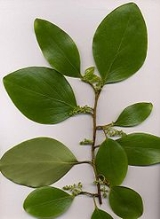
Kapuka
Encyclopedia
Griselinia littoralis, commonly known as Kapuka, is a small to medium-sized evergreen
tree
growing up to 20 m tall, though often much less, particularly in coastal exposure. It is native to New Zealand
, where it typically grows in coastal locations. It is widely cultivated both in New Zealand and in other areas with mild oceanic climates such as Great Britain
, where it is valued for its tolerance of salt
carried on sea gales.
The leaves
are alternate, leathery, glossy yellow-green above, paler and matt below, 6-14 cm long, oval with a smooth margin. The flower
s are borne on 2-5 cm long panicle
s, each panicle with 50-100 individual flowers, each flower 3-4 mm across, greenish-yellow with five sepals and stamens but no petals. The fruit
is a small blackish berry
.
Evergreen
In botany, an evergreen plant is a plant that has leaves in all seasons. This contrasts with deciduous plants, which completely lose their foliage during the winter or dry season.There are many different kinds of evergreen plants, both trees and shrubs...
tree
Tree
A tree is a perennial woody plant. It is most often defined as a woody plant that has many secondary branches supported clear of the ground on a single main stem or trunk with clear apical dominance. A minimum height specification at maturity is cited by some authors, varying from 3 m to...
growing up to 20 m tall, though often much less, particularly in coastal exposure. It is native to New Zealand
New Zealand
New Zealand is an island country in the south-western Pacific Ocean comprising two main landmasses and numerous smaller islands. The country is situated some east of Australia across the Tasman Sea, and roughly south of the Pacific island nations of New Caledonia, Fiji, and Tonga...
, where it typically grows in coastal locations. It is widely cultivated both in New Zealand and in other areas with mild oceanic climates such as Great Britain
Great Britain
Great Britain or Britain is an island situated to the northwest of Continental Europe. It is the ninth largest island in the world, and the largest European island, as well as the largest of the British Isles...
, where it is valued for its tolerance of salt
Sodium chloride
Sodium chloride, also known as salt, common salt, table salt or halite, is an inorganic compound with the formula NaCl. Sodium chloride is the salt most responsible for the salinity of the ocean and of the extracellular fluid of many multicellular organisms...
carried on sea gales.
The leaves
Leaf
A leaf is an organ of a vascular plant, as defined in botanical terms, and in particular in plant morphology. Foliage is a mass noun that refers to leaves as a feature of plants....
are alternate, leathery, glossy yellow-green above, paler and matt below, 6-14 cm long, oval with a smooth margin. The flower
Flower
A flower, sometimes known as a bloom or blossom, is the reproductive structure found in flowering plants . The biological function of a flower is to effect reproduction, usually by providing a mechanism for the union of sperm with eggs...
s are borne on 2-5 cm long panicle
Panicle
A panicle is a compound raceme, a loose, much-branched indeterminate inflorescence with pedicellate flowers attached along the secondary branches; in other words, a branched cluster of flowers in which the branches are racemes....
s, each panicle with 50-100 individual flowers, each flower 3-4 mm across, greenish-yellow with five sepals and stamens but no petals. The fruit
Fruit
In broad terms, a fruit is a structure of a plant that contains its seeds.The term has different meanings dependent on context. In non-technical usage, such as food preparation, fruit normally means the fleshy seed-associated structures of certain plants that are sweet and edible in the raw state,...
is a small blackish berry
Berry
The botanical definition of a berry is a fleshy fruit produced from a single ovary. Grapes are an example. The berry is the most common type of fleshy fruit in which the entire ovary wall ripens into an edible pericarp. They may have one or more carpels with a thin covering and fleshy interiors....
.

